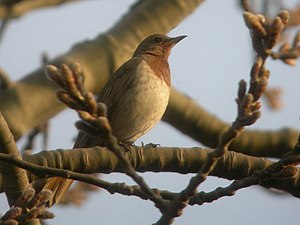Red throat
| Red throat | ||||||||||||
|---|---|---|---|---|---|---|---|---|---|---|---|---|

Red throat ( Turdus ruficollis ), male |
||||||||||||
| Systematics | ||||||||||||
|
||||||||||||
| Scientific name | ||||||||||||
| Turdus ruficollis | ||||||||||||
| Pallas , 1776 |
The Rotkehldrossel ( Turdus ruficollis ), also called Bechsteindrossel , is a songbird species from the genus of the real thrushes ( Turdus ) within the family of the thrushes (Turdidae). The specific epithet is derived from the Latin words rufus for 'red' and collum for 'neck'.
description
Appearance
The red throat reaches a body length of 24 to 27 centimeters and a weight of 63.0 to 103.0 grams. There is a slight sexual dimorphism between the sexes . In the males, the top of the head, ear covers , back, wings and control feathers are gray to gray-brown in color. The throat, including the upper chest area, is reddish brown in color. The belly and the flanks are light gray to ocher in color. The color of the plumage of the females is similar to that of the males, but it is paler overall and with a few small black spots in the throat area.
singing
The singing performed by the male consists of a series of relatively simple, short phrasing.
Distribution, migratory behavior and habitat
The distribution area of the red throat stretches from southern Siberia ( Altai and the region around Lake Baikal ) to northern Mongolia and eastern China and Myanmar . In the north of India the species can only be found as a winter visitor. Winter hikes have also been documented as far as the Gobi Desert , Japan , Taiwan , Thailand and, occasionally, to Europe. The birds inhabit forests up to an altitude of 3900 meters, river valleys as well as steppes and gardens rich in shrubbery.
Way of life
Red throats feed primarily on arthropods (Arthropoda) in summer, preferably on fruits and seeds in autumn. The feed for the nestlings consisted of 93% insects (Insecta), mainly flies (Diptera) as well as spiders (Arachnida) and earthworms (Lumbricidae). The food is mainly sought on the ground and in the low vegetation. The breeding season in Russia is between May and July. A second brood occasionally takes place there in the south. The flat, bowl-shaped nest is made from twigs, moss, mud and roots. It is often planted at low heights (less than two meters) in rotted tree stumps, sometimes also in the forks of larches ( Larix ), poplars ( Populus ) or cedars ( Cedrus ) and provided with four to five eggs. These are colored pale blue and have reddish-brown speckles. Two to four couples are happy to create their nests in the immediate vicinity. The incubation period is ten to twelve days. The offspring leave the nest after 11 to 13 days. In winter, red throat thrushes often join in mixed flocks with other thrush species.
Hazard and protection
The red throat is not uncommon in its areas of distribution and is therefore classified by the IUCN as a ![]() " Least Concern ". A maximum population density of 32 birds / km² was determined in the Altai.
" Least Concern ". A maximum population density of 32 birds / km² was determined in the Altai.
literature
- Josep del Hoyo , Andrew Elliott, David A. Christie: Handbook of the Birds of the World. Volume 10: Cuckoo-shrikes to Thrushes. Lynx Edicions, Barcelona 2005, ISBN 978-84-87334-72-6 .
Individual evidence
- ^ A b c d e N. Collar, E. de Juana & GM Kirwan. Rufous-throated Thrush (Turdus ruficollis). In: J. del Hoyo, A. Elliott, J. Sargatal, DA Christie, E. de Juana (Eds.): Handbook of the Birds of the World Alive. , Lynx Edicions, Barcelona. (viewed at http://www.hbw.com/node/58258 on March 4, 2017).
- ^ Turdus ruficollis in Russia
- ^ IUCN Red List
Web links
- Red throat (Turdus ruficollis) in the Encyclopedia of Life . Retrieved August 11, 2017.
- Turdus ruficollis at Fauna Europaea. Retrieved March 4, 2017